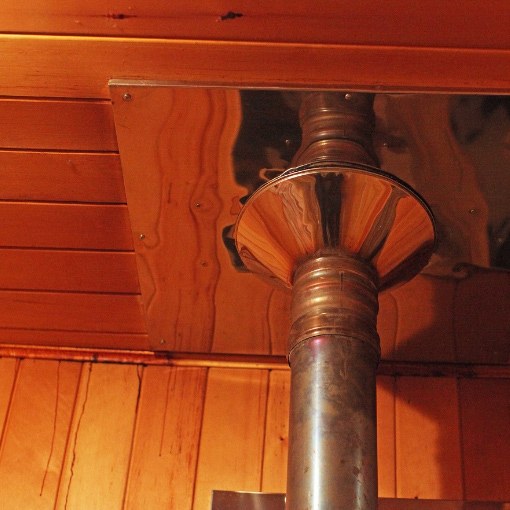Pipe insulation in bath performs several important tasks. By isolating wooden frame and roof are protected from overheating and fire. In addition, proper pipe insulation allows you to seal the roof and prevent water penetration into the attic.
In accordance with the requirements of fire safety, the temperature of the outer surface of the pipe in contact with roof elements shall not exceed 50 degrees. If the pipe is brick, this requirement is met by itself. But if the pipe is metal it should be insulated. There are several methods of isolation of pipes, most of them relies on the principle of layering and the use of insulating materials (most often mineral wool).
To avoid contact with wood, chimney in the bath should be placed in a special box at a distance of 15-20 cm from the walls. The space between the chimney and the walls of the box is filled with fireproof insulating materials based on mineral wool, broken brick or conventional dry land.
Lately, more and more popular sandwich chimneys. Internal surface is made of high-strength steel. Outside on the steel pipe put on another, with a diameter bigger. All the free space between the tubes is filled with mineral wool with a density of about 120 kilograms per square meter. In this mineral wool should withstand operating temperatures up to 700 degrees.
Modular chimneys in their design are reminiscent of sandwich chimneys. Internal pipe is ceramic and the outer shell is made of lightweight concrete. The installation of a pipe from such modules is not difficult. The blocks are secured to each other in a solution, followed by hydro at the point of passage of the pipe through the roof.
The simplest method of the pipe insulation in the bath involves wrapping it in several layers of mineral wool which is fastened to the pipe with wire. Thus the pipe turns to the passages through the roof. Top mineral wool pipe trowel the sand and clay mixture and then wrapped with a roofing steel, which is fastened with screws. This design allows you to securely insulate the pipe in the bath and to observe the rules of fire safety.
What requirements must meet the pipe in the bath
In accordance with the requirements of fire safety, the temperature of the outer surface of the pipe in contact with roof elements shall not exceed 50 degrees. If the pipe is brick, this requirement is met by itself. But if the pipe is metal it should be insulated. There are several methods of isolation of pipes, most of them relies on the principle of layering and the use of insulating materials (most often mineral wool).
Isolation boxes
To avoid contact with wood, chimney in the bath should be placed in a special box at a distance of 15-20 cm from the walls. The space between the chimney and the walls of the box is filled with fireproof insulating materials based on mineral wool, broken brick or conventional dry land.
Sandwich chimneys
Lately, more and more popular sandwich chimneys. Internal surface is made of high-strength steel. Outside on the steel pipe put on another, with a diameter bigger. All the free space between the tubes is filled with mineral wool with a density of about 120 kilograms per square meter. In this mineral wool should withstand operating temperatures up to 700 degrees.
Modular chimneys
Modular chimneys in their design are reminiscent of sandwich chimneys. Internal pipe is ceramic and the outer shell is made of lightweight concrete. The installation of a pipe from such modules is not difficult. The blocks are secured to each other in a solution, followed by hydro at the point of passage of the pipe through the roof.
Pipe insulation with their hands
The simplest method of the pipe insulation in the bath involves wrapping it in several layers of mineral wool which is fastened to the pipe with wire. Thus the pipe turns to the passages through the roof. Top mineral wool pipe trowel the sand and clay mixture and then wrapped with a roofing steel, which is fastened with screws. This design allows you to securely insulate the pipe in the bath and to observe the rules of fire safety.
